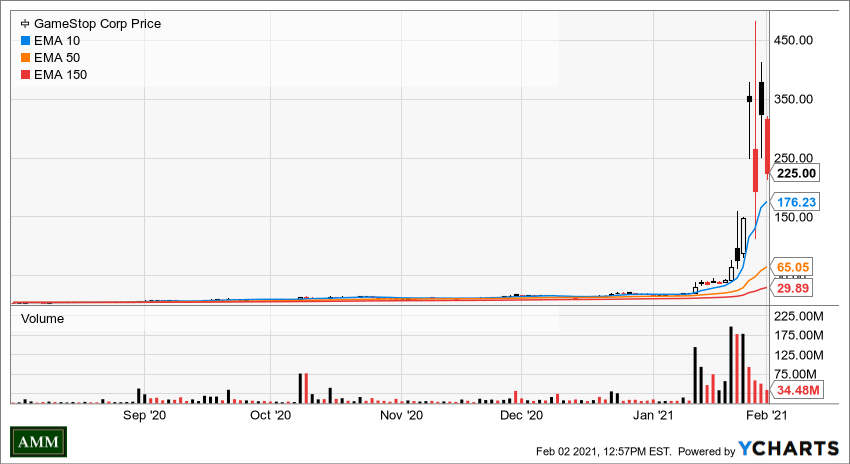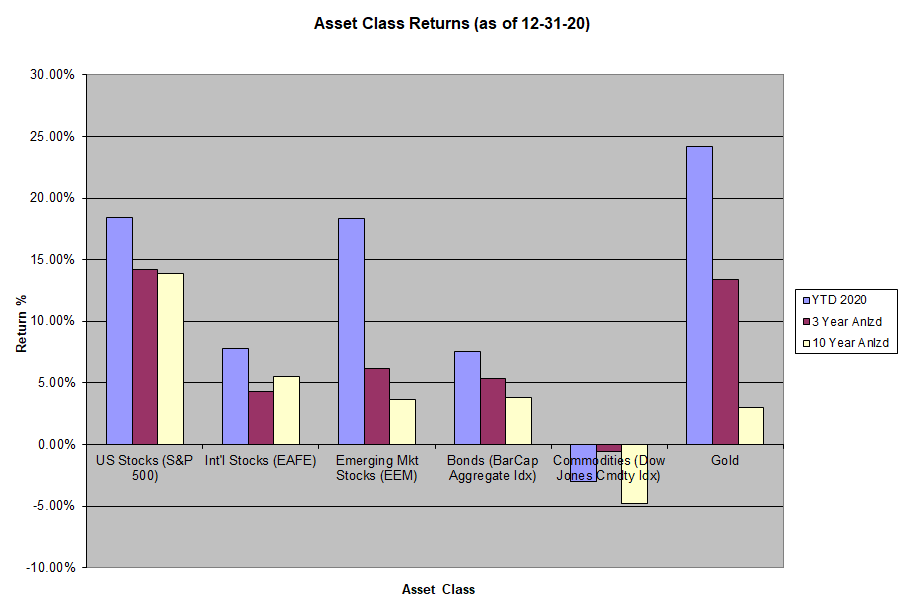Looking back over the last year reminds us why our 5th and final core investment principle is: “you cannot predict the future”. Hindsight analysis suggests the Federal Reserve induced liquidity, low interest rates, and massive fiscal stimulus were the reason for the huge rebound in stocks and other asset prices following the March 2020 market crash. But hindsight is always obvious. It is the future that is hard to predict.
As we deployed capital in late March and April of last year, we had no real idea what the trajectory of prices would be in the coming months. But by buying at depressed prices, we were improving our odds of increasing portfolio returns. This leads to our critical 2nd principle: “The price you pay determines your return”. Or rather, price matters. All else being equal, the lower the price paid for any asset, the higher your future expected return.
In fact these two principles are intertwined. If you could predict the future, then knowing the correct price to pay for any asset would be easy. Unfortunately without a crystal ball, fundamental investors must make assumptions about the underlying value and quality of an asset to determine a fair price to pay. This is the general theory of fundamental investing. It is also what makes a market of buyers and sellers. Different investors come to different conclusions about the fundamental worth of an asset. One may think an assets’ future ability to grow earnings will be impaired by a new competitor and, therefore, sells to the other investor who thinks those concerns are overblown and, in fact, the asset will continue to grow earnings at a strong enough rate to rationalize the price paid.
But there is another, less mathematical, but equally potent force that drives the behavior of market participants. John Maynard Keynes coined the term “animal spirits” in his 1936 book The General Theory of Employment to describe the instincts that influence and guide human behavior.
Even apart from the instability due to speculation, there is instability due to the characteristic of human nature that a large proportion of our positive activities depend on spontaneous optimism rather than mathematical expectations, whether moral, hedonistic or economic. Most, probably, of our decisions to do something positive, the full consequences of which will be drawn out over many days to come, can only be taken as the result of animal spirits – a spontaneous urge to action rather than inaction, and not as the outcome of a weighted average of quantitative benefits multiplied by quantitative probabilities.
‘Animal spirits’ has become a term to describe periods of immense optimism in markets, reflected by ever rising prices. Animal spirits are not inherently bad, and in fact, philosophically speaking, are probably of critical importance to the human race. Our ability to remain optimistic about the future, to take “action rather than inaction”, are characteristics that have led us to survive and adapt to a harsh world.
But when high animal spirits lead to a complete disconnect of price from fundamentals investors need to proceed with caution. The Crash of ’29, the 70’s bear-market and the ’99-00 dot com bubble were all preceded by periods of high animal spirits. All ended with a lost decade (or more) of returns, as the high prices paid near the peak led to a long period before investors “broke even”. High animal spirits themselves do not cause crashes, in our view, but they do create the environment for “bubbly” behavior to flourish, and for extreme non-fundamental pricing of assets. Taken to the extreme this behavior results in a bubble which ultimately bursts.
Dominating the financial news cycle in recent weeks is case in point: GameStop (GME). The stock of this struggling company has completely disconnected from its underlying economic reality. A company that lost 30% in revenue over the last year, with negative earnings and high levels of debt went up nearly 1600% in less than 3 weeks. The price paid or poor underlying fundamentals didn’t matter to the buyers of GME, who were buying solely because they expected the price to keep going up (for a variety of non-fundamental factors). This is speculation in its purest form.
The speculative action in GME is one example of many that have proliferated in recent weeks and months. But trying to time some tipping point in animal spirits is no easy task either; in fact it is just another form of speculation. Which brings us back to our core principle #2: the price paid determines your return. We do not need to speculate or try to figure out the next turn of the market. As investors our goal is to temper our animal spirits not feed them, and to see an asset for what it is fundamentally, not what a greater fool may pay for it. Price matters.
By focusing on underlying fundamentals, we look to buy assets at prices that make economic sense, and to hold them for as long as possible to benefit from power of compounding returns. Along the way we will run in to bear markets, crashes, spikes in volatility and a myriad of other risks. But by sticking to our core investment principles, and avoiding speculation, we believe we can improve the odds of achieving our dual goal of protecting and growing our clients wealth.
2020 Year in Review
Through 12/31/20
- Domestic stocks (S&P 500) increased 18.4%
- Developed international stocks (EAFE) increased 7.8%
- Emerging market stocks (EM) increased 18.3%
- Bonds (Bar Cap AGG) increased 7.5%
- Commodities (DJCI) declined -2.9%
- Gold increased 24.2%
We have updated our asset class return chart below.
2021 Outlook*
Since the pandemic hit last winter, actions by the Federal Reserve and Fiscal authorities have generated significant stimulus to help bridge the output gap caused by the pandemic. With more stimulus slated for early 2021, it is likely that economic conditions remain accommodative, and barring any major exogenous set back (see proliferation of new vaccine resistant virus strain), we expect conditions to continue to improve year over year. In the second ½ of the year we expect to get a clearer picture of how well our fiscal and monetary programs have worked to stave off lasting economic harm. Stay tuned.
As highlighted above, we see “frothiness” in certain areas of the market. But we are also able to identify stocks and sectors where prices are still fundamentally grounded. For clients in our dividend growth strategy, we continue to seek businesses with high returns on invested capital with either a long history of raising their dividends or a new commitment to dividend growth. Stocks with growing dividend payouts offer our clients a bird-in the hand via a cash return today vs. waiting for price appreciation only. Other less frothy areas of the market include international developed and emerging market stocks, which have been major laggards relative to domestic stocks over the last 10 years, leaving them with relatively attractive valuations.
In traditional fixed income, there is little return to be found with interest rates near 1% on the ten year treasury note. But in a diversified portfolio we view positions in shorter-term investment grade fixed income securities as providing a ballast to future volatility and a potential source of liquidity in the event of a major market sell-off.
AMM Welcomes Rana Davidson to the Team!
In January, Rana Davidson, CPA joined AMM as a Financial Planning and Client Services associate. Rana earned her Bachelor’s degree in Accounting from the University of San Diego’s Business School. She began her career in Public Accounting as an auditor with KPMG, LLP before working as a Senior Analyst of Technical Accounting with Cubic Corporation. She maintains an active Certified Public Accountant (CPA) license and has successfully passed the CERTIFIED FINANCIAL PLANNER ® Exam. Rana is a San Diego native and enjoys hiking and camping with her husband.
Housekeeping
Should you have any questions regarding your investment account(s) and personal financial plans, or if there have been any recent changes to your investment and/or retirement objectives, please do not hesitate to contact our office to speak with one of us at your convenience. We can also provide you with a current copy of our SEC Form ADV Part 2, at your request.
As always, we thank you for entrusting AMM to help you achieve your investment and retirement objectives.
Your Portfolio Management Team





